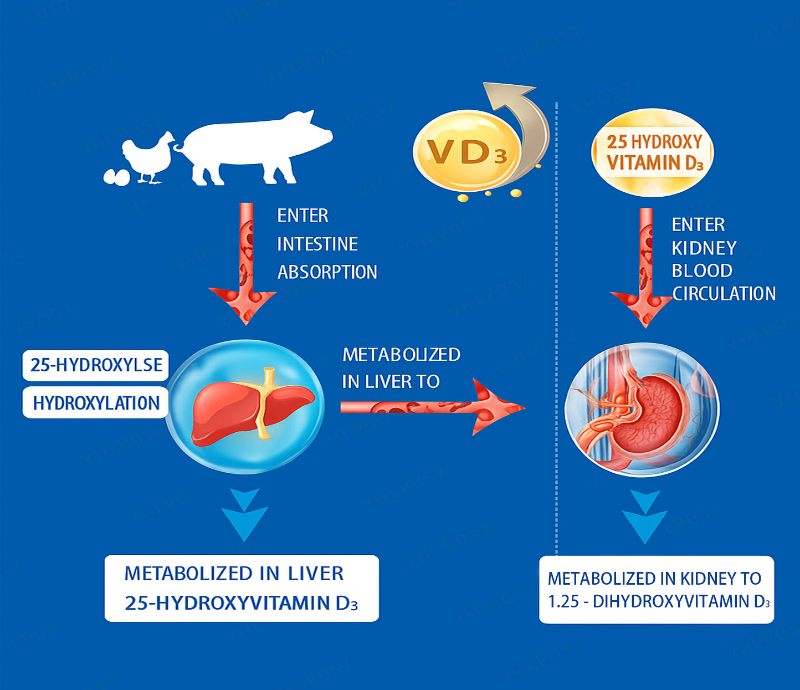25-Hydroxyvitamin D₃ (25-OH-D₃) is gainingincreasing attention in animal nutrition due to its superior absorption andefficacy compared to traditional Vitamin D₃. As synthetic biology advances its production and formulation, itis essential to understand its benefits, applications, and gl......
25-Hydroxyvitamin D₃ (25-OH-D₃) is gaining
increasing attention in animal nutrition due to its superior absorption and
efficacy compared to traditional Vitamin D₃. As synthetic biology advances its production and formulation, it
is essential to understand its benefits, applications, and global guidelines
for effective use.
Why is 25-OH-D₃ Absorbed More Efficiently?
Unlike fat-soluble Vitamin D₃, which depends on bile salts and intact intestinal mechanisms for absorption, 25-OH-D₃ is a hydroxylated form readily absorbed directly by small intestinal cells. This bypass allows for higher and more consistent bioavailability, particularly valuable in livestock with compromised fat digestion [1].

Stability and Bioavailability: Biosynthetic vs. Chemical 25-OH-D₃
Both biosynthetic and chemically synthesized 25-OH-D₃ are often formulated using microencapsulation, enhancing their stability against heat, acid-base conditions, and storage challenges. The intestinal absorption depends primarily on product purity and concentration, rather than the synthesis method [2].
Recommended Supplementation Levels
Internationally recognized nutritional guidelines and research support the following supplementation ranges:
The optimal Vitamin D₃ level within these ranges may vary depending on the animal’s growth or production stage. For swine, requirements can differ between piglets, growers, and sows; for poultry, adjustments are often made between early laying, peak production, and late laying phases to align with bone mineralization and reproductive demands [3][4].
Key Benefits Across Animal Types
Layers:
Broilers:
Breeders:
Evaluation Metrics in Trials
To assess 25-OH-D₃ efficacy, focus on:
A Global Perspective on Regulations and Use
While local regulatory frameworks differ, internationally recognized bodies such as the NRC (National Research Council) provide extensive guidance on Vitamin D metabolites in animal feed. Supplement users should always consult current regulations in their regions, as well as rely on validated scientific literature to optimize inclusion rates and ensure compliance [3][4].
Disclaimer: This article compiles information from publicly available research and is intended for informational purposes only. It does not constitute veterinary advice or prescription. Individual results may vary based on genetics, management, and environment.
References:
[1] Bar, A., et al. (2010). “Vitamin D metabolism and requirements in poultry: physiological and production considerations.” Poultry Science, 89(4), 805–813.
[2] Glatzle, J., et al. (2017). “Stability and bioavailability of encapsulated vitamins in animal feed.” Animal Feed Science and Technology, 225, 1–10.
[3] National Research Council. (2012). Nutrient Requirements of Swine, 11th ed.
[4] National Research Council. (1994). Nutrient Requirements of Poultry, 9th ed.
[5] Fleming, R.H., et al. (2006). “Bone strength and eggshell quality in laying hens supplemented with 25-hydroxycholecalciferol.” British Poultry Science, 47(5), 570–576.
[6] Driver, J.P., et al. (2005). “Effect of dietary 25-hydroxycholecalciferol on broiler performance.” Journal of Applied Poultry Research, 14(4), 623–629.
[7] Saunders-Blades, J.L., et al. (2009). “Effect of 25-hydroxyvitamin D₃ on reproduction and hatchability in broiler breeders.” Poultry Science, 88(9), 1903–1908.
Next:6 Essential Q&As About 25-Hydroxyvitamin D₃ You Should Know
Prev:Understanding 25-Hydroxyvitamin D₃: Applications and Guidance

On November 12, at the 93rd API China in Chongqing, we showcased a range of our bio-manufactured ingredients. This builds on our October showcase at CPHI Frankfurt 2025, underscoring our focused strategy for...
[ Details ]Nov 14,2025